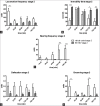Mice Behavioral Phenotype Changes after Administration of Anani (Symphonia globulifera, Clusiaceae), an Alternative Latin American and African Medicine
- PMID: 29200723
- PMCID: PMC5701401
- DOI: 10.4103/pm.pm_168_17
Mice Behavioral Phenotype Changes after Administration of Anani (Symphonia globulifera, Clusiaceae), an Alternative Latin American and African Medicine
Abstract
Background: Anani, (Symphonia globulifera, Clusiaceae), known as chewstick, is a traditional plant occurring in Africa and in Central and South Americas that is used against parasites and microorganisms. Although its use is popular in some of these countries, there is a lack of information related to its influence over behavioral phenotype (BP).
Objective: The objective of this study is to evaluate the influence of the administration of the extract obtained from the aerial organs of Anani (EB1257) to male Balb-c mice over BP.
Materials and methods: Open cage observation, open field, and elevated-plus maze apparatuses were used. Evaluations were done 15, 30, 60, 120, and 180 min after intraperitoneal administration of Anani extract.
Results: Impairment of general behavior activity, response to touch, tail squeeze, defecation, locomotion and rearing frequency were observed although no signs of hemorrhage or macroscopical alterations of internal organs. Anani is harmful, but not toxic if used in the appropriate doses, yet to be determined to male mice. Impairment of locomotion and defecation was observed, indicating some degree of influence over locomotion, but no alterations in anxiety levels were assessed. Three compounds were previously found in the plant-lupeol (1), β-amyrin (2) and 3-β-hydroxyglutin-5-ene (3), and one is being described for the first time to occur in the species: oleanolic acid (4).
Conclusions: The present work contributes in the support of the rational use of Anani, an important Latin American and African alternative medicine, presenting findings that are being reported for the first time.
Summary: Symphonia globulifera impairs locomotion and defecatin in behavior analysesNo alterations in anxiety was observedOleanolic acid occurs in the species. Abbreviations used: BP: Behavioral phenotype; OF: Open field, EPM: Elevated-plus maze, MMA/ICMBio/SISBIO: Ministério do Meio Ambiente/Instituto Chico Mendes de Conservação da Biodiversidade/Sistema de Autorização e Informação em Biodiversidade, IBAMA/MMA/CGen: Instituto Brasileiro do Meio Ambiente e dos Recursos Naturais Renováveis/Ministério do Meio Ambiente/Conselho de Gestão do Patrimônio Genético, AM: Amazonas State, UNIP: Universidade Paulista, mg: milligram, kg: kilogram, I.P: Intraperitoneal, CEUA/ICS/UNIP: Comissão de Ética no Uso de Animais/Instituto de Ciências da Saúde/Universidade Paulista, LD: Lethal dose, NLD: Nonlethal dose, GBA: General behavior activity, FCHCL3: Fraction chloroform, FBuOH: Fraction buthanol, FH2O: Fraction water, FrHEX: Fraction hexane, FrDCM: Fraction dichloromethane, FrMeOH: Fraction methanol, 13C NMR: Carbon nuclear magnetic resonance, EPA: United States Environmental Protection Agency.
Keywords: Behavioral phenotype; Symphonia globulifera; general activity; locomotion.
Conflict of interest statement
There are no conflicts of interest.
Figures





Similar articles
-
COVID-19 and zoonoses in Brazil: Environmental scan of one health preparedness and response.One Health. 2022 Jun;14:100400. doi: 10.1016/j.onehlt.2022.100400. Epub 2022 May 14. One Health. 2022. PMID: 35601224 Free PMC article.
-
[The occurrence of Biomphalaria straminea (Pulmonata: Planorbidae) on an aquaculture farm of IBAMA in Uberlândia, MG. Instituto Brasileiro do Meio Ambiente a dos Recursos Naturais Renováveis].Rev Soc Bras Med Trop. 1997 Sep-Oct;30(5):401-3. doi: 10.1590/s0037-86821997000500010. Rev Soc Bras Med Trop. 1997. PMID: 9380901 Portuguese.
-
Symphonia globulifera, a widespread source of complex metabolites with potent biological activities.Planta Med. 2015 Jan;81(2):95-107. doi: 10.1055/s-0034-1396148. Epub 2015 Jan 15. Planta Med. 2015. PMID: 25590372 Review.
-
The ancient tropical rainforest tree Symphonia globulifera L. f. (Clusiaceae) was not restricted to postulated Pleistocene refugia in Atlantic Equatorial Africa.Heredity (Edinb). 2013 Jul;111(1):66-76. doi: 10.1038/hdy.2013.21. Epub 2013 Apr 10. Heredity (Edinb). 2013. PMID: 23572126 Free PMC article.
-
A prenylated xanthone with antimicrobial activity from the seeds of Symphonia globulifera.Nat Prod Res. 2005 Jan;19(1):23-7. doi: 10.1080/14786410310001643876. Nat Prod Res. 2005. PMID: 15700641
Cited by
-
Constituents of the Stem Bark of Symphonia globulifera Linn. f. with Antileishmanial and Antibacterial Activities.Molecules. 2023 Mar 8;28(6):2473. doi: 10.3390/molecules28062473. Molecules. 2023. PMID: 36985446 Free PMC article.
References
-
- Ssegawa P, Kasenene JM. Medicinal plant diversity and uses in the Sango bay area, Southern Uganda. J Ethnopharmacol. 2007;113:521–40. - PubMed
-
- Lopez A, Hudson JB, Towers GH. Antiviral and antimicrobial activities of Colombian medicinal plants. J Ethnopharmacol. 2001;77:189–96. - PubMed
-
- Gupta MP, Solís PN, Calderón AI, Guionneau-Sinclair F, Correa M, Galdames C, et al. Medical ethnobotany of the Teribes of Bocas del Toro, Panama. J Ethnopharmacol. 2005;96:389–401. - PubMed
-
- Nkengfack AE, Mkounga P, Fomum ZT, Meyer M, Bodo B. Globulixanthones A and B, two new cytotoxic xanthones with isoprenoid groups from the root bark of Symphonia globulifera. J Nat Prod. 2002;65:734–6. - PubMed
-
- Dick CW, Heuertz M. The complex biogeographic history of a widespread tropical tree species. Evolution. 2008;62:2760–74. - PubMed
LinkOut - more resources
Full Text Sources
Other Literature Sources
Research Materials
Miscellaneous
